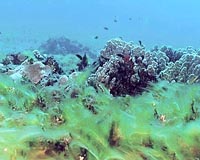| . |  |
. |
New Orleans, Louisiana (AFP) July 29, 2010 US officials sought Thursday to reassure fishermen they will not lose out in the next phase of the Gulf of Mexico oil clean-up, while legal wranglings began for the BP trial of the decade. As final preparations were put in place for operations next week to permanently kill the well, US spill chief Thad Allen convened a meeting of parish presidents in New Orleans to discuss how best to safeguard local jobs going forward. With less oil floating in the Gulf, there are fears BP might scrap its "Vessels of Opportunity" program which employs more than 1,500 boats, providing desperate fishermen with vital skimming and boom-laying work. "If BP uses the capping of the well as an excuse to minimize its clean-up operations, then shame on them," said Captain Mike Frenette, whose five boats in Venice, Louisiana missed an entire summer's fishing due to the disaster. Frenette had to apply four times before getting two of his five boats onto the program, which pays between 600 and 3,500 dollars a day, depending on the size of the boat. "The paperwork kept getting lost," he said. "And all that our Vessels of Opportunity work is doing is counting against our compensation claim. We're not making any money, here, we're just trying to keep our heads above water." A large portion of the Gulf waters remain closed to commercial and recreational fishing and with lingering doubts about seafood safety, fishermen could effectively end up losing their jobs for a second time. "The fishermen have missed a year, and we don't know what the impact is going to be next year, or the year after that," said Marty O'Connell, an environmental scientist at the University of New Orleans. Clean-up crews are collecting samples of fish and shrimp at depths of between 30 and 360 feet to test them for contaminants, but it will take years to fully know the impact of the oil disaster on Gulf fisheries. Allen pledged earlier this week to keep as many "Vessels of Opportunity" as possible, hoping they could be redeployed to test for any underwater plumes. A massive task also lies ahead in picking up some 20 million feet (3,800 miles) of protective boom laid to protect Gulf shores from the once-giant slick that has now diminished to just a few patches of light sheen. Ahead of the meeting with Allen, Saint Tammany parish president Kevin Davis, said he was against reducing any oil-fighting resources for the time-being. "Although the well is capped, we cannot let down our guard until we are absolutely certain that no oil lingers under our waters," he said. Meanwhile, BP lawyers were set to come face-to-face Thursday with victims of the spill during a first court hearing into the case, which is likely to become the trial of the decade. The hearings in Boise, Idaho, will examine whether complaints submitted by some 200 plaintiffs can be consolidated. A decision is expected around two weeks after the hearing, but the session will give trial lawyers a test run for the arguments they will make during what could be years-long legal proceedings. Law professor Richard Nagareda said the seven federal judges of the Multidistrict Litigation Panel (MDL Panel) could in theory choose to send one consolidated case to any US federal court. The hearing will bring together a wide array of people and players linked to the disaster triggered by an April 20 explosion aboard the Deepwater Horizon rig, which killed 11 and caused the platform to sink two days later. Joining BP are Transocean, which leased the rig to the British energy giant, and Cameron International, which manufactured the blowout preventer, the device which should have shut down the well but failed to work properly. Plaintiffs range from the families of the 11 workers killed in the explosion to Gulf fishermen whose catch has been contaminated by the spill, threatening them with financial ruin. Richard Arsenault, a lawyer for the plaintiffs, said he expected pre-trial hearings to be held in Louisiana, the Gulf state closest to site of the BP-leased Deepwater Horizon rig. BP hopes to begin a "static kill" operation on Monday to plug the capped well with drilling mud and cement. Five days later a "bottom kill" through a relief well should finish the job once and for all. A cap stopped the flow on July 15 after between three and 5.2 million barrels (117.6 million and 189 million gallons) had gushed out, making the Deepwater Horizon disaster likely the biggest ever accidental oil spill.
Share This Article With Planet Earth
Related Links Water News - Science, Technology and Politics
 Declining algae threatens ocean food chain: study
Declining algae threatens ocean food chain: studyParis (AFP) July 28, 2010 A century-long decline in tiny algae called phytoplankton could disrupt the global ocean food chain, including the human consumption of fish, according to a study released Wednesday. The microscopic organisms - which prop up the pyramid of marine animal life from shrimps to killer whales - have been disappearing globally at a rate of one percent per year, researchers reported. Since 19 ... read more |
|
| The content herein, unless otherwise known to be public domain, are Copyright 1995-2010 - SpaceDaily. AFP and UPI Wire Stories are copyright Agence France-Presse and United Press International. ESA Portal Reports are copyright European Space Agency. All NASA sourced material is public domain. Additional copyrights may apply in whole or part to other bona fide parties. Advertising does not imply endorsement,agreement or approval of any opinions, statements or information provided by SpaceDaily on any Web page published or hosted by SpaceDaily. Privacy Statement |